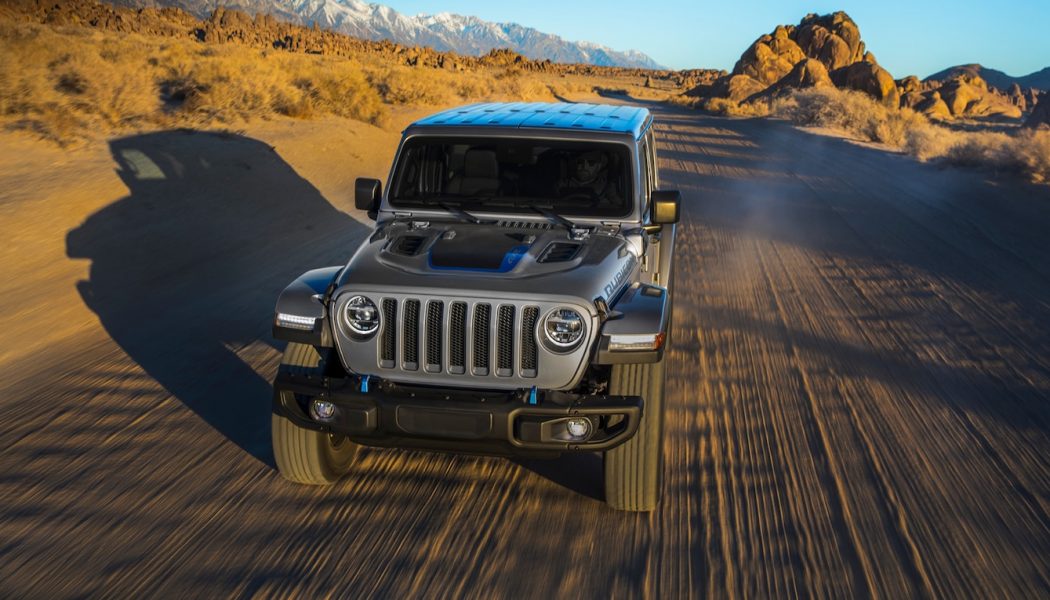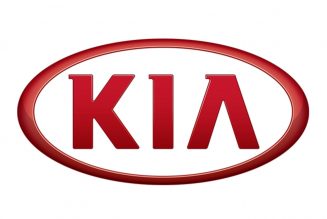Over the weekend the EPA quietly updated its website with the latest mpg figures for the much-anticipated plug-in hybrid electric 2021 Jeep Wrangler 4xe. When Jeep introduced the hybrid Wrangler in late 2020, it estimated that the SUV would be able to drive up to 25 miles on electricity alone.
We now know that Jeep was a tad optimistic (almost 20 percent, actually) in that figure, as the official EPA estimate for the 2021 Jeep Wrangler 4xe‘s pure-electric range comes in at 21 miles. That’s 4 miles fewer than originally estimated, for those keeping score at home. It also is several fewer miles than Stellantis’s only other plug-in hybrid, the older Chrysler Pacifica minivan, achieves using a larger V-6 gas engine and a smaller 16-kWh battery (32 miles of EV-only operation). Even in terms of MPGe (miles per gallon equivalent), the Wrangler 4xe scores a low 49 MPGe—the aforementioned Pacifica minivan nails 89 MPGe when a full charge of the battery is taken into account.
On the flip side of things, when running the Wrangler 4xe gasoline-only mode, meaning the batteries are completely depleted and the gas engine and electric motor combine to behave like a normal hybrid, the Wrangler is rated at 20 mpg combined on regular unleaded gasoline. That’s not bad, but it’s also not the best you’ll find in the Wrangler lineup—it’s on par with a base, two-door, V-6-powered model with the six-speed manual transmission. The available turbocharged four-cylinder gas engine does better (up to 23 mpg combined), while the available EcoDiesel V-6 tops the lineup with 25 mpg combined. At the other end of the efficiency spectrum sits the gas-swilling, 14-mpg-combined new Rubicon 392, which is powered by a 470-hp V-8 engine.
Why is the Wrangler 4xe the lowest of the bunch? The best we can figure is it’s from the added weight from the electric drive equipment. Its hybrid setup is composed of Jeep’s turbocharged 2.0-liter four-cylinder engine, an electric motor, and a 17-kWh battery pack.
So, what’s the solution for getting the best bang-for-the-buck out of the 2021 Jeep Wrangler 4xe? Maximize electric range and fully utilize its hybrid ability. With drives shorter than 20 miles it’s a no-brainer. Drive on pure electric and plug in between outings. If the journey is going to be longer than 20 miles it’s best to use the Jeep’s hybrid function, which maximizes the use of both the gasoline engine and electric motors.
The EPA estimates that driving the 2021 Jeep Wrangler 4xe 25 miles on a combination of gasoline and electricity will cost $2.37, while using just the gasoline engine will bring the cost to $3.56. In terms of yearly fuel cost (gasoline and electricity in the case of the Wrangler 4xe), the EPA estimates that it will cost $1,750 to drive 15,000 miles. By comparison, the EPA estimates that the non-hybrid, 2.0-liter powered Wrangler will need $1,950 worth of fuel for those same 15,000 miles.
Not really into the hybrid Wrangler 4xe and tempted by the deep exhaust rumble of the Wrangler 392? The EPA estimates that the Wrangler 392’s 470 hp 6.4-liter V-8 will return a combined fuel economy of just 14 mpg, which translates to a thirst for premium fuel amounting to $3,750 each year. In this context, sure, the Wrangler 4xe seems pretty good.
At a few hundred bucks a year of fuel savings relative to normal Wranglers, however, it’ll take years to recoup the Wrangler 4xe Rubicon’s $1,000-to- $4,000 price premium over a comparable 2.0-liter four-cylinder Wrangler Unlimited Rubicon. However, this doesn’t take into account the Federal tax credit that is currently available. So, deciding whether it’s worth it or not, from a pure cost standpoint, is probably best figured out on a case-by-case basis. As with any plug-in hybrid, the more you can drive on pure electricity, the better the cost equation becomes. Of course, your mileage will vary.










